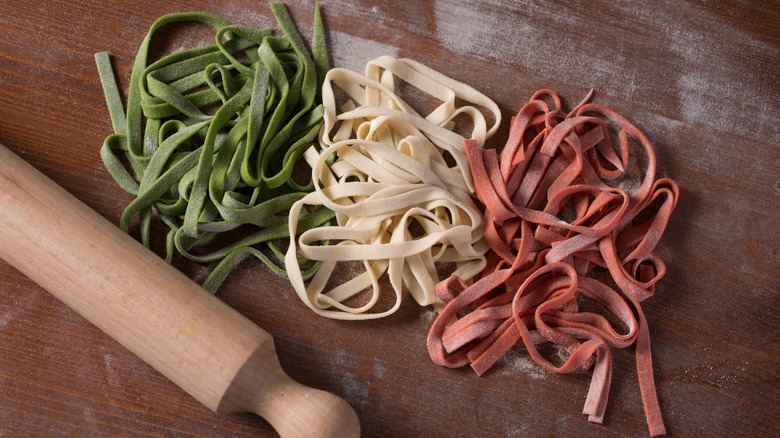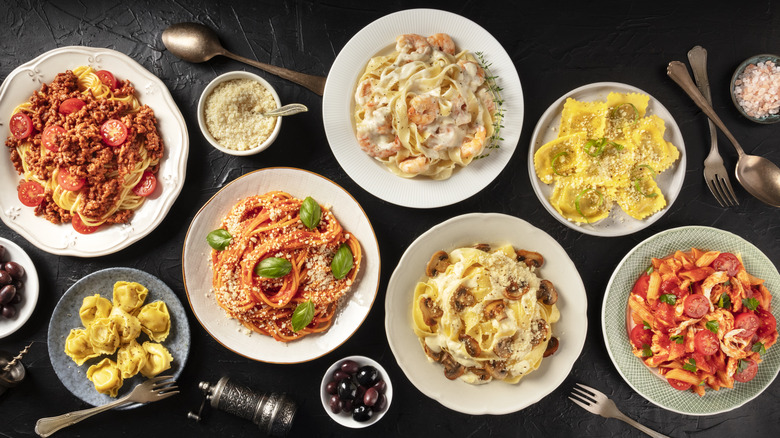How Pasta Became An Icon Of Italian Culture
When people around the world think of Italian food, their minds often go right to pasta, usually along with pizza. Outside of the nation itself, these two dishes might be the most popular icons of Italian cuisine, but while the roots of pizza begin in the Mediterranean country, historical documents tell a different story about pasta.
Contrary to popular belief, the explorer Marco Polo probably was not the first person to bring noodles from China to Italy, thus beginning the age of Italian pasta. Historians don't know exactly how the concept of wheat noodles traveled from Asia to Europe, but the people of Italy undoubtedly took the most interest in the newfangled foodstuff, compared to its neighboring countries. What really helped pasta earn a place in the daily lives of Italians was that the staple was affordable, lasted a long time in its dried state, and was incredibly versatile.
Think of the countless shapes that can be formed from a basic pasta dough, and add that to the plentiful ingredients native to each region of Italy. It's easy to see how Italians all over the country found dozens and dozens of uses for the noodles, and many specific pastas dishes are now identifiable with certain cities and regions of the country, from cacio e pepe in Rome to various stuffed pastas from northern Italy.
How did pasta come to Italy?
The details of pasta's creation and expansion around the world are uncertain. Its origin has to be pieced together from various written accounts, and sometimes artwork (if such pieces have survived the years for us to interpret). The aforementioned Marco Polo tale falls short because there is evidence of pasta being enjoyed in Italy long before the famous merchant came home in the 1200s, bearing the gift of noodles.
In his personal texts from the year 1154, an Arab geographer named Muhammad al-Idrisi describes mass quantities of pasta being made in Sicily, supposedly seen during his travels there. Some believe that the Etruscans, a pre-Roman civilization based in modern-day Tuscany, were making pasta as early as the fourth century B.C., based on an ancient painting. However, others believe the artwork depicts equipment for making flatbread.
It is indeed likely that Italian pasta is a derivative of Chinese noodles, which were created during the Shang Dynasty. The concept eventually made its way west, gaining particular popularity in Africa and the Middle East. By the time it reached the Mediterranean region, noodles were being made with durum wheat instead of rice or a barley-like meal. Wheat gave pasta a higher gluten content and more shelf-stability. Despite its long journey over time, modern pasta has amazingly stayed true to its roots, being made with essentially the same ingredients as its early iterations.
Italians have kept their love for pasta alive
What sort of reputation can pasta boast today, beyond being undoubtedly delicious? While people around the world enjoy pasta as an easy weeknight meal, it's a hundred times more important in Italy. For starters, there were 110 industrial pasta factories in Italy in 2021, according to Statista, and the country churned out almost 4 million metric tons of pasta during the same year. This, unsurprisingly, was the highest pasta output in the world, followed by the United States.
When it comes to family time, which Italians hold in high regard, you would be hard pressed to find a gathering that doesn't include a large bowl of pasta, or even several types for everyone to enjoy. In a nutshell, it's a food that encourages togetherness, as it feeds a lot of people for a low cost, yet a family can bond in making and enjoying their own.
Italian nonnas or grandmothers often teach their children and grandchildren how to make pasta by hand, encouraging the next generation to embrace the mighty noodle as something of value, and reminding them that it has deep roots in their ancestry. Whether you're in an Italian restaurant, watching an Italian movie, or reading about life in Italy, pasta is sure to be present, because the two simply go hand in hand.



